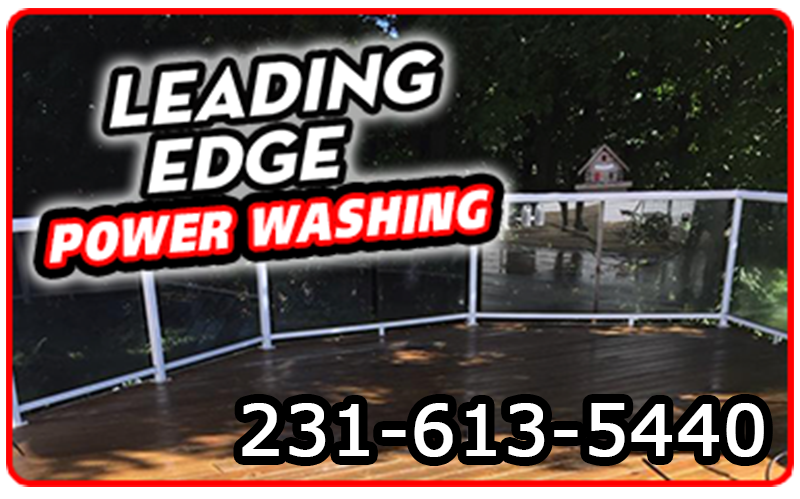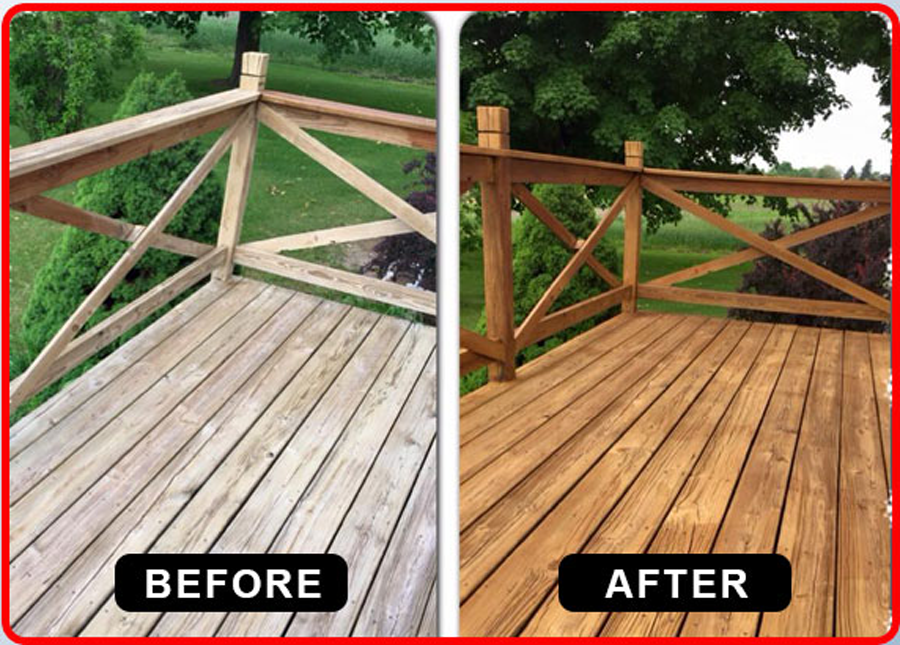

LEADING EDGE
POWER WASHING
BENEFITS OF DECK POWER WASHING
So you have rented a pressure washer from the local rental store. The sales clerk assures you that this machine will clean your deck “no problem.” You get home and now what? The “Do It Yourselfer” that you are figures that washing the deck is a task that can be achieved rather easily. This may or not be the case. The next step is setting up the machine. You hook up the water supply lines, (Note most require a ¾ inch inline hose.) You attach the high pressure hose, and the gun, and turn on the water. Pulling the engine recoil cord the machine roars to life. . You approach the deck point the tip at the deck, you nervously squeeze the trigger and a jet of water comes forth. The next thing you know your cleaning your deck. Right? Maybe, then again maybe not. You release the trigger and inspect your work realizing that you did in fact remove the dirt but you also removed ¼” of wood leaving behind a board that looks more like a sea shell than the nice flat board you had only moments ago. The DIY’er deck cleaner you thought you were has mutated into a DYI wood engraver. The words ‘No Problem’ echo in your mind and you’re left with a damaged deck and a bruised ego.Of all the questions I receive about cleaning a deck the most often asked question is “HOW?” So, this is going to begin a series of articles on how to clean you deck. Whether you deck is wood or composite, periodic cleaning is a requirement if you want your deck to retain the beauty it had on day one. Periodic cleaning is preventative maintenance. This maintenance, do correctly, will do more than add years to your deck; it can save you valuable time and money in the long run.
As mentioned in previous articles, the pressure you need to wash your deck surface is rarely more than 1500 pounds per square inch (PSI). This is still enough pressure to do damage to soft wood, and enough pressure to leave lap marks on most composite decking. Remember: less is more when it comes to pressure washing. The pressure washer serves a mechanism to remove embedded dirt and other contaminants. Excessive forces on the wood will remove much more than those pollutants you want removed The operators hand will be the only measure as to when too much pressure has be exerted. Having said that, it is the cleaner that should do most of the work in removing the dirt.
Cleaners come in all shapes, claims, colors. Some are detergents, others are bleaches, and still others are chemical solutions designed to react with certain woods. There is no one clear answer as to what cleaner you should use. Whatever cleaner you do decide on, be sure to read the manufacturer’s directions carefully, and follow them to the letter. If you ARE going to use a pressure washer, remember that the job of the pressure washer is to remove the chemicals as well as the surface dirt. A pressure washer uses less water than a conventional hose and nozzle. Removing the residue of the cleaner is far easier with a pressure washer in that the cleaner is forced off the wood, and merely diluted. Allow the cleaner to do as much of the work as possible.
A stiff bristle brush should be a part of your deck cleaning arsenal. The brush should be synthetic not natural bristle. Many cleaning solutions will deteriorate natural bristle brushes. Also, you will find that a good synthetic bristle will give you many years of performance. The brush should be outfitted to a long handle. It should be capable of reaching all the places you need it to reach. Rarely will one brush work for all your needs, so if you need multiple brushes, by all means get them. The right tool for the job can make all the difference.
Scrub the deck. Sometimes lightly watering down the deck can assist you in applying and spreading the cleaning solutions. Many solutions should not be allowed to dry on the wood so periodic spraying/misting may be required. Depending on how dirty the deck is you may see the results immediately. But often the cleaning compounds require a small period of time to be down the imbedded contaminants.
Once you have scrubbed the entire deck you are now ready for rinsing. Again, a conventional hose and nozzle may work. But if you are going to use a pressure washer, this next section will instruct you on the correct techniques to use. NOTE: Sometimes raising woods fibers is a direct result of applying pressurized water to a wood surface. Even the most cautious technique may leave behind these raised fibers. These raised fibers can be removed rather easily. More on that later.
Always engage the trigger away from the surface, and away from anything that it may harm including windows and people. The water that emerges from the tip is called a ‘fan.’ The tip is rated in degrees. The degree of angle indicates the fan size. Zero (0’) is typically a stream of water. You will never want to apply a stream of pressurized water to wood. A 40’ to 60’ (degree) tip size is standard for cleaning a deck. Bringing the fan to the surface you want to sweep the deck.
Begin “Sweeping” the deck from the house side out. Be consistent in the length you tip it from the surface. This constancy will prevent lap marks. The goal in sweeping a deck with a pressure washer is to remove the dirt leaving behind no traces of the pressurized water. Too little pressure, or having the fan too far from the water will result in a ‘less’ cleaner surface. Too high pressure, or too close to the wood will result in a stripped area. In sweeping the surface you need to begin and end with the same pressure.